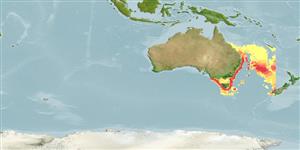Common names from other countries
Environment: milieu / climate zone / depth range / distribution range
Ecologia
marinhas; Água doce; estuarina bentopelágico; catádromo (Ref. 9258); intervalo de profundidade 0 - 3000 m (Ref. 86942). Subtropical; 18°S - 47°S, 140°E - 168°E
Southwest Pacific: east coast of Australia and New Zealand, extending north to New Caledonia. Museum records from Fiji and Tahiti are doubtful. Australian and New Zealand forms sometimes recognized as subspecies. Most easily confused with Anguilla obscura and the surest way of distinguishing them is to count the vertebrae. Reported from Western and American Samoa (Ref. 592).
Tamanho / Peso / Idade
Maturity: Lm ? range ? - ? cm
Max length : 130 cm TL macho/indeterminado; (Ref. 40637); 106.5 cm TL (female); common length : 45.0 cm TL macho/indeterminado; (Ref. 9258); common length :65 cm TL (female); peso máx. Publicado: 7.5 kg (Ref. 40637); Idade máx. registada: 32 anos (Ref. 6390)
Occurs in streams, lakes and swamps. More likely inhabits slow flowing streams or still waters (Ref. 26509). Feeds on fishes, crustaceans, mollusks, worms, aquatic plants, and terrestrial and aquatic insects. This species does not breed outside its Pacific spawning ground. Migrates to the sea to breed (Ref. 9258). Maximum length for female eel taken from Ref. 6390. Migrating females in Lake Ellesmere (Canterbury, New Zealand) were reported to be in the range of 48.3 to 102.4 cm, larger than for males 33.8 to 55.4 cm (Ref. 44724). Despite its slimy appearance, its flesh is of excellent quality, considered a delicacy in many countries; meat suitable for smoking (Ref. 33839).
Allen, G.R., 1989. Freshwater fishes of Australia. T.F.H. Publications, Inc., Neptune City, New Jersey. (Ref. 5259)
Categoria na Lista Vermelha da IUCN (Ref. 130435)
CITES (Ref. 128078)
Not Evaluated
Ameaça para o homem
Harmless
Utilização humana
Can't connect to MySQL database (fbapp). Errorcode: Too many connections
